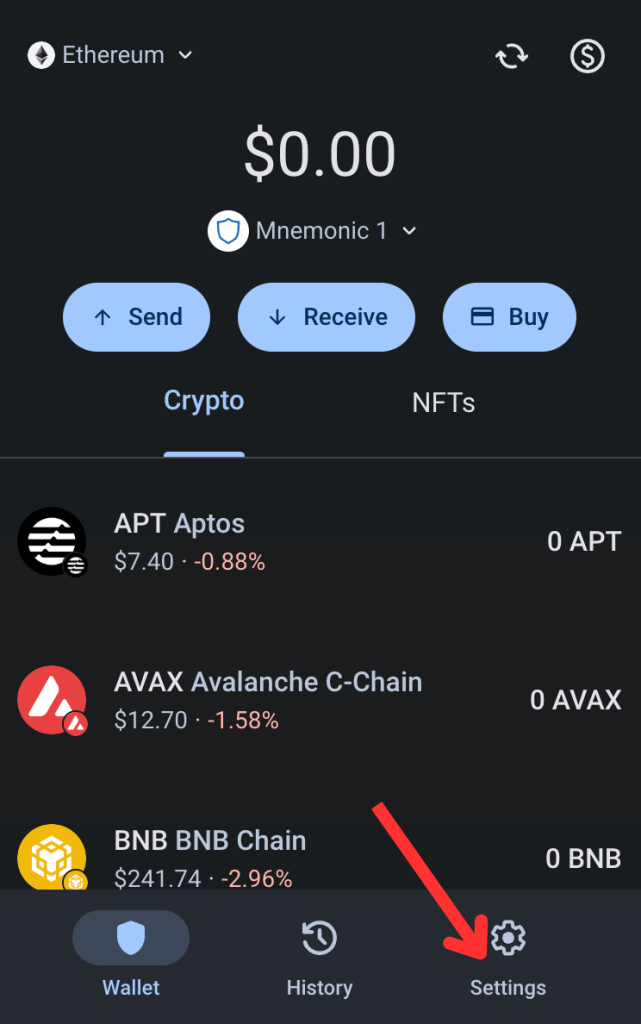
To protect your Trust Wallet, use a strong password, enable 2FA, back up your recovery phrase, and keep your device secure.
Setting Up a Strong Password for Trust Wallet
Why a Strong Password is Crucial for Wallet Security
A strong password is vital to protect your Trust Wallet from unauthorized access. It safeguards your assets by preventing unauthorized users from gaining entry, especially if your device is compromised.
-
Security Reasons:
-
Protects your wallet from unauthorized access.
-
Adds an extra layer of security with your recovery phrase.
-
Safeguards against device theft or hacks.
-
How to Create a Secure Password for Trust Wallet
To create a secure password, it should be long, complex, and unique. This reduces the risk of security breaches.
-
Best Practices:
-
Use 12-16 characters with a mix of letters, numbers, and symbols.
-
Avoid personal information and common words.
-
Use a password manager for secure storage.
-
Don’t reuse passwords across different accounts.
-

Enabling Two-Factor Authentication (2FA) on Trust Wallet
What is Two-Factor Authentication (2FA) and How Does It Help?
Two-Factor Authentication (2FA) enhances security by requiring both your password and a second verification, typically a code sent to your phone or email.
-
Benefits of 2FA:
-
Increases security by adding a second layer.
-
Prevents unauthorized access, even with a compromised password.
-
Reduces the risk of hacking.
-
Steps to Enable 2FA on Trust Wallet for Enhanced Security
Enabling 2FA is simple and adds extra protection to your wallet.
-
Steps:
-
Open Trust Wallet and go to settings.
-
Select Security and find the 2FA option.
-
Choose your 2FA method (Google Authenticator or SMS).
-
Follow the setup instructions and confirm.
-

Backing Up Your Recovery Phrase for Trust Wallet
Why a Recovery Phrase is Essential for Wallet Recovery
Your recovery phrase is a critical component of Trust Wallet’s security. It’s a set of 12 or 24 words that act as a backup to restore your wallet if you lose access to your device or forget your password. Without it, you risk losing access to your assets permanently.
-
Importance of the Recovery Phrase:
-
Provides a way to restore your wallet in case of device loss or malfunction.
-
Gives you full control over your funds without relying on third-party services.
-
Essential for recovering your assets if you forget your password or face technical issues.
-
How to Safely Store and Backup Your Trust Wallet Recovery Phrase
It’s crucial to store your recovery phrase securely to prevent unauthorized access and ensure your assets remain safe.
-
Best Practices for Storing the Recovery Phrase:
-
Write it down on paper and store it in a secure location (e.g., a safe or lockbox).
-
Avoid storing it digitally (e.g., on your phone or online) to protect against hacking.
-
Consider using a metal backup to protect it from fire or water damage.
-
Do not share your recovery phrase with anyone, and keep it out of sight from others.
-
Keeping Your Device Secure to Protect Trust Wallet
Best Practices for Securing Your Mobile Device
Securing your mobile device is essential for protecting Trust Wallet from unauthorized access. Since your private keys and recovery phrase are stored on your device, maintaining device security helps safeguard your funds.
-
Best Practices for Device Security:
-
Use a strong password or PIN to lock your device.
-
Enable biometric authentication (e.g., fingerprint or facial recognition) for added security.
-
Install a reputable antivirus to protect against malware and malicious apps.
-
Keep your operating system updated to protect against known vulnerabilities.
-
Avoid public Wi-Fi when accessing your wallet, as it can expose your device to potential risks.
-
How Device Security Affects the Safety of Your Trust Wallet
Device security directly impacts the safety of your Trust Wallet, as any vulnerabilities in your device can expose your wallet to hacking or theft. If your device is compromised, your recovery phrase or private keys could be accessed by unauthorized parties, leading to a potential loss of funds.
-
Impact of Device Security:
-
A compromised device increases the risk of losing control over your wallet.
-
Ensuring your device is secure helps protect your recovery phrase and private keys from being stolen.
-
Device security measures like encryption and secure authentication provide an extra layer of protection.
-

Avoiding Phishing Attacks and Scams with Trust Wallet
How to Recognize and Avoid Phishing Attacks
Phishing attacks are designed to trick you into revealing personal information such as your private keys or recovery phrase. These attacks can come in the form of fake websites, emails, or messages pretending to be from Trust Wallet or other crypto services.
-
Signs of Phishing Attacks:
-
Suspicious Links: Avoid clicking on links in unsolicited emails or messages. Always verify the URL to ensure it’s from the official Trust Wallet website.
-
Too Good to Be True Offers: Be cautious of offers promising free coins, rewards, or giveaways that require your private information.
-
Unsolicited Communication: Trust Wallet will never ask for your recovery phrase, private keys, or password through email or message.
-
Urgent Requests: Phishing attempts often pressure you to act quickly. Always take your time and verify the request’s legitimacy.
-
What to Do if You Suspect a Scam Involving Trust Wallet
If you suspect that you’ve encountered a scam or phishing attempt, it’s important to act immediately to protect your wallet and assets.
-
Steps to Take:
-
Do Not Share Information: Never share your private keys, recovery phrase, or passwords with anyone, even if they seem to be from Trust Wallet.
-
Verify Official Sources: Always check the official Trust Wallet website or official social media channels for information or updates.
-
Report the Scam: Report the phishing website or scam attempt to Trust Wallet’s support team or the platform where the scam originated.
-
Secure Your Wallet: If you suspect that your wallet has been compromised, move your assets to a new wallet using your recovery phrase on a secure device.
-

Using Hardware Wallets for Extra Protection of Your Assets
What is a Hardware Wallet and Why Should You Use One?
A hardware wallet is a physical device that stores cryptocurrency private keys offline, offering increased security by keeping them away from online threats like hacking and malware.
-
Benefits:
-
Offline Storage: Keeps private keys secure offline.
-
Enhanced Security: Uses encryption and physical confirmation for transactions.
-
Malware Protection: Immune to malware attacks targeting online wallets.
-
How to Connect Your Trust Wallet to a Hardware Wallet for Added Security
Connecting Trust Wallet to a hardware wallet adds an extra layer of protection for your assets.
-
Steps:
-
Purchase a compatible hardware wallet (e.g., Ledger or Trezor).
-
Set up the hardware wallet as per the instructions.
-
In Trust Wallet, go to settings and select the hardware wallet option.
-
Follow the prompts to connect via USB or Bluetooth.
-

Regularly Updating Trust Wallet for Security Improvements
The Importance of Keeping Trust Wallet Updated
Regular updates are crucial for maintaining the security and functionality of Trust Wallet. Each update addresses potential vulnerabilities, improves security features, and ensures compatibility with new cryptocurrencies and blockchain technologies.
-
Why Updates Matter:
-
Security Patches: Fixes known vulnerabilities to protect your assets.
-
New Features: Enhances wallet functionality with new features and improvements.
-
Compatibility: Ensures the wallet works with the latest blockchain updates.
-
How to Ensure You Are Using the Latest Version of Trust Wallet
Ensuring you have the latest version of Trust Wallet is simple and helps protect your assets with the latest security updates.
-
How to Check for Updates:
-
On iOS: Go to the App Store and check for updates in the “Updates” section.
-
On Android: Open the Google Play Store, search for Trust Wallet, and tap “Update” if available.
-
Enable Auto-Updates: Ensure automatic updates are enabled in your device settings for seamless security upgrades.
-
How Can I Secure My Trust Wallet From Hackers?
To secure your Trust Wallet from hackers, use a strong password, enable two-factor authentication (2FA), and avoid sharing your recovery phrase with anyone.
What Is the Best Way to Backup My Trust Wallet?
The best way to backup your Trust Wallet is by securely storing your recovery phrase offline in a safe place, like a lockbox, and never digitally storing it.
Can I Use a Hardware Wallet for Extra Protection?
Yes, using a hardware wallet with Trust Wallet offers extra protection by keeping your private keys offline, reducing the risk of online attacks.

Leave a Reply